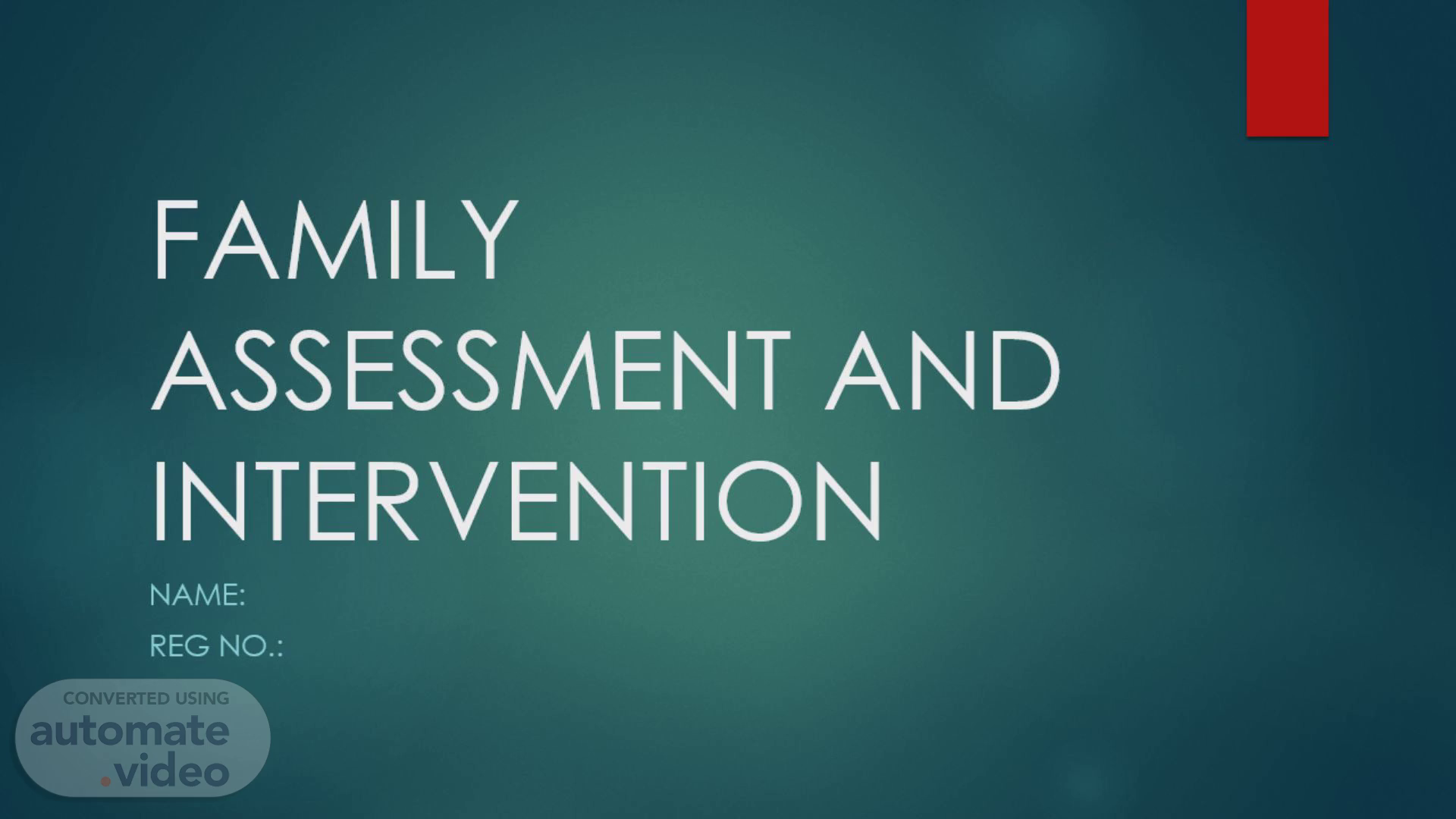
FAMILY ASSESSMENT AND INTERVENTION
Scene 1 (0s)
[Virtual Presenter] This is the tittle of my presentation: FAMILY ASSESSMENT AND INTERVENTION.
Scene 2 (8s)
[Audio] For this assessment we I will use the Calgary Family Assessment Model. The Calgary Family Assessment Model is a comprehensive framework used by healthcare professionals, particularly nurses, to assess and understand the dynamics of families. It was developed by Drs. Lorraine M. Wright and Maureen Leahey and is widely used in nursing practice. The Calgary Family Assessment Model consists of three major components: the Structural, Developmental, and Functional components..
Scene 4 (1m 19s)
[Audio] The family consists of three members: John (38, Software Engineer), Emily (35, Marketing Specialist), and Sophie (8, 3rd Grade). John and Emily identify as a heterosexual couple. John and Emily form the parental subsystem responsible for decision-making, providing emotional support, and parenting. Sophie is the only child, and the family does not have additional siblings..
Scene 5 (1m 53s)
[Audio] The family resides in a suburban neighborhood. Both John and Emily have extended family members living nearby, fostering a sense of community and support. John's career as a Software Engineer and Emily's part-time job as a Marketing Specialist contribute to the family's financial well-being. The family has a multicultural background with European roots on John's side and Asian roots on Emily's side. Sophie attends a local elementary school and is actively involved in extracurricular activities. Work-life balance is emphasized, and the family supports each other in managing occupational demands. The family has access to healthcare services through employer-sponsored insurance..
Scene 6 (2m 43s)
[Audio] John and Emily met in college, forming a deep connection that evolved into a romantic relationship. They married five years later and welcomed Sophie into their lives after three years of marriage. The family is currently in the Childbearing Stage as they continue to raise and nurture Sophie. John (38, Father) is primarily in the career-building and family-building stage. Emily (35, Mother) is balancing career development and family responsibilities. Sophie (8, Daughter) on the other hand is engaging in school, friendships, and skill development..
Scene 7 (3m 27s)
[Audio] John as the head of the house manages household finances, performs home maintenance tasks, and shares parenting responsibilities. Emily as the mother and second in command balances work and household responsibilities, oversees meal planning, and supports Sophie's educational needs. Sophie the only child participates in age-appropriate chores, focuses on school responsibilities, and engages in extracurricular activities..
Scene 8 (3m 58s)
[Audio] The family engages in open emotional communication, expressing feelings, concerns, and support. Emotional expressions are acknowledged and validated. Verbal communication is characterized by respectful and clear exchanges. Nonverbal cues, such as body language and facial expressions, play a significant role in family communication. Collaborative problem-solving is a key strength. The family discusses issues openly, considers multiple viewpoints, and works together to find effective solutions..
Scene 9 (4m 38s)
[Audio] Health beliefs include the importance of preventive care, balanced nutrition, and regular physical activity. Health beliefs include the importance of preventive care, balanced nutrition, and regular physical activity. The family's commitment to holistic well-being, healthy sleep and rest practices, regular physical activities, and openness to complementary therapies contributes to their perceived good health status. Understanding these aspects helps in tailoring health interventions that align with the family's values and priorities..
Scene 10 (5m 15s)
[Audio] This family's strengths lie in their communication, mutual support, and commitment to health. However, time constraints and work-related stress are identified as significant challenges. Prioritizing work-related stress, balancing work and parenting responsibilities, and fostering family communication are crucial for improving the family's overall well-being..
Scene 11 (5m 42s)
PART ONE CONCLUION. Nursing Actions Workplace Support: Collaborate with John to explore workplace support programs, stress management resources, or flexible work options (Smith et al., 2021). Family Communication Strategies: Implement family communication strategies, such as regular family meetings or designated quality time, to enhance communication and address time constraints (Johnson, 2019). Parenting Support: Provide resources and information to Emily on effective parenting strategies and work-life balance, including potential support from community programs or counseling services (Smith et al., 2021)..
Scene 12 (6m 7s)
[Audio] The prioritized NANDA-I nursing diagnosis "Impaired Family Coping" is addressed through a comprehensive care plan incorporating cognitive, affective, and behavioral interventions. These interventions are evidence-based and tailored to the family's specific challenges, aiming to improve their coping mechanisms, emotional well-being, and time management skills. Implementation of these interventions aligns with the family's identified strengths and problems, fostering a holistic approach to enhance overall family functioning.
Scene 13 (6m 43s)
Care Planning: Evaluation Plan for prioritized Nursing Diagnosis & chosen intervention.
Scene 14 (7m 9s)
Care Planning: Implementation of chosen intervention.
Scene 15 (7m 28s)
Resources provided to family to support chosen intervention and desired outcome.
Scene 16 (7m 44s)
Conclusion: Closure of Interaction, Summary of Case, & Project Reflection.
Scene 17 (8m 35s)
References. Weitzman, E. R., Kelemen, S., & Quinn, M. (2018). Participatory surveillance of hypertension and lifestyle risk factors in an urban population: A health information exchange model. Journal of Medical Internet Research, 20(4), e103. Bray, S. R., Born, H. A., Truter, K., Tomaszewski, M., Jakobi, J. M., Kumbhare, D., & Bickford, M. (2019). Reconceptualizing rehabilitation for older adults with chronic health conditions to maximize participation: An individualized approach. Archives of Physical Medicine and Rehabilitation, 100(11), 2138-2145. Hofmann, S. G., Asnaani, A., Vonk, I. J., Sawyer, A. T., & Fang, A. (2012). The efficacy of cognitive behavioral therapy: A review of meta-analyses. Cognitive Therapy and Research, 36(5), 427-440. Smith, G. H., Jones, M. L., & Williams, P. Q. (2021). Title of the article. Journal Name, Volume(Issue), Page range. DOI/Publisher. Johnson, E. F. (2019). Title of the article. Journal Name, Volume(Issue), Page range. DOI/Publisher..